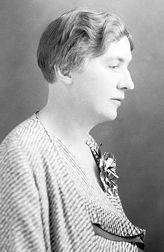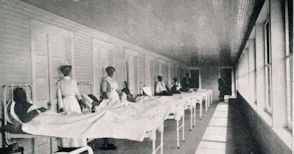Search the Blog
Categories
- Books & Reading
- Broadband Buzz
- Census
- Education & Training
- General
- Grants
- Information Resources
- Library Management
- Nebraska Center for the Book
- Nebraska Memories
- Now hiring @ your library
- Preservation
- Pretty Sweet Tech
- Programming
- Public Library Boards of Trustees
- Public Relations
- Talking Book & Braille Service (TBBS)
- Technology
- Uncategorized
- What's Up Doc / Govdocs
- Youth Services
Archives
Subscribe
Author Archives: Devra Dragos
Friday Reads: The Care and Management of Lies, by Jacqueline Winspear
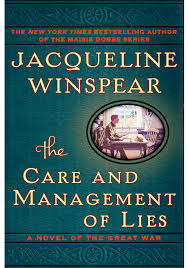 Also set in World War I, this book is written from a different perspective than the book Mary Jo wrote about two weeks ago. The story opens in England on a hopeful note with Kezia Marchant preparing for her wedding to Tom Brissenden just weeks before war is declared. It is a poignant story of love, friendships, changing relationships, differing philosophies, duty, sacrifice, and bravery. The lies of the title include those in the letters Tom writes from the trenches to limit Kezia’s concerns, and Kezia’s unique stories in return of the delicious meals she dreams up to serve him instead of worrying him about changes on their farm. Other characters lie to themselves or live lies to justify their actions and beliefs. This story provides a very human look at how the stresses of war can affect individuals, families, friends, communities and cultures.
Also set in World War I, this book is written from a different perspective than the book Mary Jo wrote about two weeks ago. The story opens in England on a hopeful note with Kezia Marchant preparing for her wedding to Tom Brissenden just weeks before war is declared. It is a poignant story of love, friendships, changing relationships, differing philosophies, duty, sacrifice, and bravery. The lies of the title include those in the letters Tom writes from the trenches to limit Kezia’s concerns, and Kezia’s unique stories in return of the delicious meals she dreams up to serve him instead of worrying him about changes on their farm. Other characters lie to themselves or live lies to justify their actions and beliefs. This story provides a very human look at how the stresses of war can affect individuals, families, friends, communities and cultures.
This is a standalone book, but Jacqueline Winspear also writes the Maisie Dobbs series set in England after World War I.
Dining Out
Did you run out and pick up lunch today? Do you plan to eat out tonight? Are you out on the road and need a place to eat?
 People have had a variety of choices for cafes, restaurants, steak houses, etc. in Nebraska over the years. Options included formal and informal. Al fresco dining outside this restaurant was offered in the early 1900s. The photograph to the left captures a crowd at a restaurant offering an outside lunch counter option (Nebraska State Historical Society Collection). Photographer John Nelson took many pictures in the area surrounding Wheeler County where he lived.
People have had a variety of choices for cafes, restaurants, steak houses, etc. in Nebraska over the years. Options included formal and informal. Al fresco dining outside this restaurant was offered in the early 1900s. The photograph to the left captures a crowd at a restaurant offering an outside lunch counter option (Nebraska State Historical Society Collection). Photographer John Nelson took many pictures in the area surrounding Wheeler County where he lived.
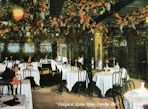
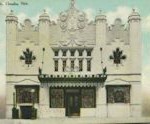 More formal dining at about the same time was in order at the Vineyard in Omaha’s Rome Hotel at 16th and Jackson Streets, shown in the postcard far left. The wait staff there may have been as numerous as that of the Calumet Restaurant (1411-1413 Douglas Street, Omaha) shown in the postcard bottom left. Tolf Hanson, after selling the Calumet to his brother-in-law, opened Hanson’
More formal dining at about the same time was in order at the Vineyard in Omaha’s Rome Hotel at 16th and Jackson Streets, shown in the postcard far left. The wait staff there may have been as numerous as that of the Calumet Restaurant (1411-1413 Douglas Street, Omaha) shown in the postcard bottom left. Tolf Hanson, after selling the Calumet to his brother-in-law, opened Hanson’ s Cafe in 1908, a tony restaurant that didn’t quite catch on despite extensive, expensive interior renovations. The building now houses the Omaha’s oldest Chinese restaurant at 315 S. 16th Street. (Omaha Public Library Collection)
s Cafe in 1908, a tony restaurant that didn’t quite catch on despite extensive, expensive interior renovations. The building now houses the Omaha’s oldest Chinese restaurant at 315 S. 16th Street. (Omaha Public Library Collection)
Steak houses have also been big in Nebraska for a number of years. 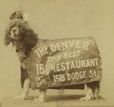 The Denver Chop House at 1518 Dodge Street, used cutting edge advertising in 1894, to promote their 15 Cent Restaurant on the postcard at the top left (Omaha
The Denver Chop House at 1518 Dodge Street, used cutting edge advertising in 1894, to promote their 15 Cent Restaurant on the postcard at the top left (Omaha 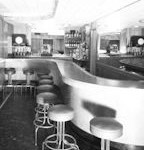 Public Library Collection). Opening somewhat later, Gorat’s Steakhouse, 4917 Center Street, Omaha, was and is a popular dining establishment. Cooks in the basement kitchen of Gorat’s Steak House cut generous portions of steak in the 1949 photograph at the left.
Public Library Collection). Opening somewhat later, Gorat’s Steakhouse, 4917 Center Street, Omaha, was and is a popular dining establishment. Cooks in the basement kitchen of Gorat’s Steak House cut generous portions of steak in the 1949 photograph at the left. 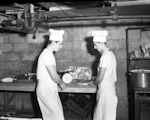 While upstairs in the photograph to the right, patrons could enjoy a drink at the sleek bar before eating. (The Durham Museum Collection)
While upstairs in the photograph to the right, patrons could enjoy a drink at the sleek bar before eating. (The Durham Museum Collection)
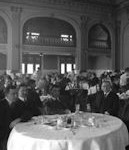
 In Lincoln, businessmen could eat formally in the Commercial Club dining room on an upper floor of 1110 P Street as they do in the photograph to the left. Or someone in a hurry could grab a bite at the Jenquenz Sanitary Lunch Car a few blocks away at 222 S. 11th Street shown in the photograph to the right. (Townsend Studio Collection)
In Lincoln, businessmen could eat formally in the Commercial Club dining room on an upper floor of 1110 P Street as they do in the photograph to the left. Or someone in a hurry could grab a bite at the Jenquenz Sanitary Lunch Car a few blocks away at 222 S. 11th Street shown in the photograph to the right. (Townsend Studio Collection)
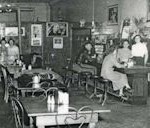
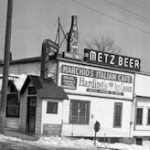 Locals and teenagers had their own favorite hangouts. Mrs. Tony’s Cafe in Fairmont with its pinball machine was popular with young people in town shown at left. (Fairmont Public Library Collection) Marchio’s Italian Cafe was part of the neighborhood at 13th and J Streets in Omaha, photograph to the right. (The Durham Museum Collection)
Locals and teenagers had their own favorite hangouts. Mrs. Tony’s Cafe in Fairmont with its pinball machine was popular with young people in town shown at left. (Fairmont Public Library Collection) Marchio’s Italian Cafe was part of the neighborhood at 13th and J Streets in Omaha, photograph to the right. (The Durham Museum Collection) 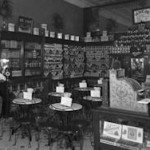 And anyone wanting something from the soda fountain had many choices in Lincoln, including Joe Gatto’s Store, to the left. (Townsend Studio Collection)
And anyone wanting something from the soda fountain had many choices in Lincoln, including Joe Gatto’s Store, to the left. (Townsend Studio Collection)
So, where are we going and what’s for dinner?
Visit Nebraska Memories to search for or browse through many more historical images digitized from photographs, negatives, postcards, maps, lantern slides, books and other materials.
Nebraska Memories is a cooperative project to digitize Nebraska-related historical and cultural heritage materials and make them available to researchers of all ages via the Internet. Nebraska Memories is brought to you by the Nebraska Library Commission. If your institution is interested in participating in Nebraska Memories, see http://nlc.nebraska.gov/nebraskamemories/participation.aspx for more information, or contact Beth Goble, Historical Projects Librarian, or Devra Dragos, Technology & Access Services Director.
Posted in General, Information Resources, Nebraska Memories
Leave a comment
Beat of a Different Drummer
The group performing on the corner a block away for the Friday lunch hour, as I work on this blog post, not only reinforces the fact that everyone has their own taste in music and preference for a “beat” but also the importance of music to humans.
Music has played a big part in Nebraska’s cultural history; in Nebraska Memories, you can browse through our new category of Musical Performers which includes photographic images people of different times, ages, and backgrounds.

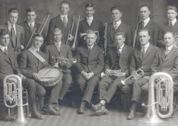
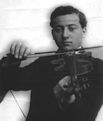 Some student musicians like young Madessa Wolfe, far left, (Harvey L. Boston, Butler County Gallery Collection) enjoyed private music lessons while others learned to play in school bands–high school or college like the 1917 Nebraska Normal College Band, above center, (Wayne State College Collection). Faculty at the University School of Music in Lincoln, such as Carl Steckelberg, above right, (Polley Music Library Collection) not only taught music but also performed regularly.
Some student musicians like young Madessa Wolfe, far left, (Harvey L. Boston, Butler County Gallery Collection) enjoyed private music lessons while others learned to play in school bands–high school or college like the 1917 Nebraska Normal College Band, above center, (Wayne State College Collection). Faculty at the University School of Music in Lincoln, such as Carl Steckelberg, above right, (Polley Music Library Collection) not only taught music but also performed regularly.
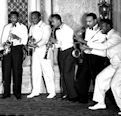
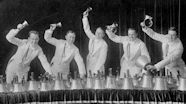 Outside of school, bands and orchestras were formed by families, friends, and church and community members. Some were amateurs while others were professional like this Orchestra featuring all male African American musicians, at left (William Wentworth, The Durham Museum Collection). For a time, performers the bell ringers to the left (Alva C. Townsend, Townsend Studio Collection) could be booked through the Chautauqua.
Outside of school, bands and orchestras were formed by families, friends, and church and community members. Some were amateurs while others were professional like this Orchestra featuring all male African American musicians, at left (William Wentworth, The Durham Museum Collection). For a time, performers the bell ringers to the left (Alva C. Townsend, Townsend Studio Collection) could be booked through the Chautauqua.
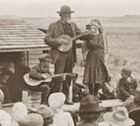 Performers made music outdoors in bandstands, fields, parades or on a makeshift stage as in the photo to the right, of a man, boy and girl (John Nelson, Nebraska State Historical Society Collection). Indoor venues included school stages, auditoriums, churches, ball rooms, concert halls, opera houses, prisoner of war camps, orphanages and other institutions.
Performers made music outdoors in bandstands, fields, parades or on a makeshift stage as in the photo to the right, of a man, boy and girl (John Nelson, Nebraska State Historical Society Collection). Indoor venues included school stages, auditoriums, churches, ball rooms, concert halls, opera houses, prisoner of war camps, orphanages and other institutions.
 Choirs also played an important role in the musical scene. The Great Cathedral Choir shown here in the State Capitol (Polley Music Library Collection) performed regularly in Lincoln starting in 1919. Singers also played parts on stage in musicals or took part in concerts. The Polley Music Library Collection includes many concert programs featuring visiting and local performers.
Choirs also played an important role in the musical scene. The Great Cathedral Choir shown here in the State Capitol (Polley Music Library Collection) performed regularly in Lincoln starting in 1919. Singers also played parts on stage in musicals or took part in concerts. The Polley Music Library Collection includes many concert programs featuring visiting and local performers.
 So, whether you prefer an indoor or outdoor performance, a formal orchestra or the beat of a single drummer like Chief Bear Dog (John Anderson, Nebraska State Historical Society Collection), take a look at the items representing the rich musical history of Nebraska.
So, whether you prefer an indoor or outdoor performance, a formal orchestra or the beat of a single drummer like Chief Bear Dog (John Anderson, Nebraska State Historical Society Collection), take a look at the items representing the rich musical history of Nebraska.
Visit Nebraska Memories to search for or browse through many more historical images digitized from photographs, negatives, postcards, maps, lantern slides, books and other materials.
Nebraska Memories is a cooperative project to digitize Nebraska-related historical and cultural heritage materials and make them available to researchers of all ages via the Internet. Nebraska Memories is brought to you by the Nebraska Library Commission. If your institution is interested in participating in Nebraska Memories, see http://nlc.nebraska.gov/nebraskamemories/participation.aspx for more information, or contact Beth Goble, Historical Projects Librarian, or Devra Dragos, Technology & Access Services Director.
Posted in Nebraska Memories
Leave a comment
New Memories
Have you visited Nebraska Memories recently? Check it out–we not only have a new look but three new collections, too!
Omaha Public Schools contributed a number of historical photographs of schools (inside and out) and pupils. Garden County Historical Society contributed a manuscript of “Recollections,” a collation of newspaper articles which detailed the history of businesses, people and events of Oshkosh and the county. And Rock County Public Library’s audio interviews conducted in 1982 with nine of the county’s long-time residents will be available early next week.
The software used to host Nebraska Memories, CONTENTdm®, has been updated with a number of new features, including:
- You can now search within a collection or narrow search results by collection, subject, creator, type, date or search term.
- The Zoom feature now allows a much closer look at details in any image.
- Audio files now play from within the item record.
- For postcards that have a transcript, the front and back of the postcard can be viewed side-by-side or the text can be viewed side-by-side with the writing on the postcard. The text may also be searched. Try it out with this postcard: Farnam Street, Omaha, Neb. (Omaha Public Library collection)
- For documents in PDF with transcripts, the text can be searched and the image of the page can be viewed side-by-side with the text.
Commission staff created predefined searches for topics unique within most of the individual collections. We also, under Browse, added ten new topic groups to provide access to items of interest across the all the collections, including Famous Nebraskans, Interiors and Medical.
Visit Nebraska Memories to search for or browse through many more historical images digitized from photographs, negatives, postcards, maps, lantern slides, books and other materials.
Nebraska Memories is a cooperative project to digitize Nebraska-related historical and cultural heritage materials and make them available to researchers of all ages via the Internet. Nebraska Memories is brought to you by the Nebraska Library Commission. If your institution is interested in participating in Nebraska Memories, seehttp://nlc.nebraska.gov/nebraskamemories/participation.aspx for more information, or contact Beth Goble, Historical Services Librarian, or Devra Dragos, Technology & Access Services Director.
Posted in Nebraska Memories, Technology
Leave a comment
High-Rises of the Plains
Ding, ding! Going up … Oh, not that kind of elevator? An “elevator” in the country is different from an “elevator” in the city. Almost every town in Nebraska had a grain elevator at one time–right next to the train tracks. The railroads brought the farmers to the plains, then the farmers grew crops and brought grain to the railroads to be shipped back. But it had to be stored somewhere while waiting for transportation.
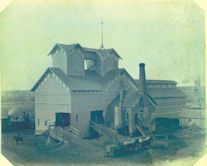
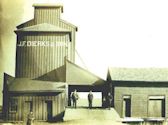 Elevators were originally built to store and move grain from docks into ships, but they worked just as well with trains. The mechanized “elevator” that moved the grain up and into silos sometimes used buckets and sometimes conveyor belts. Some towns had multiple elevators. The grain elevator pictured to the left was likely built by Seely, Son and Company of Fremont, Nebraska (Keene Memorial Library Collection). The picture to the right shows another elevator in Fremont, J.F. Dierks and Son.
Elevators were originally built to store and move grain from docks into ships, but they worked just as well with trains. The mechanized “elevator” that moved the grain up and into silos sometimes used buckets and sometimes conveyor belts. Some towns had multiple elevators. The grain elevator pictured to the left was likely built by Seely, Son and Company of Fremont, Nebraska (Keene Memorial Library Collection). The picture to the right shows another elevator in Fremont, J.F. Dierks and Son.
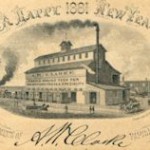
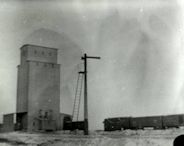 Elevator buildings might be plain or fancy, but they were originally all built of wood. The simple grain elevator to the left was outside of Omaha (Omaha Public Library Collection). Sometimes a company would combine its elevator with a mill to grind the grain before it was shipped. At the right is an illustration of such a company advertising its services with a New Year’s postcard from the A.W. Clarke Grain and Ground Feed in Papillion (Sarpy County Historical Museum Collection).
Elevator buildings might be plain or fancy, but they were originally all built of wood. The simple grain elevator to the left was outside of Omaha (Omaha Public Library Collection). Sometimes a company would combine its elevator with a mill to grind the grain before it was shipped. At the right is an illustration of such a company advertising its services with a New Year’s postcard from the A.W. Clarke Grain and Ground Feed in Papillion (Sarpy County Historical Museum Collection).
Additional images of grain elevators from towns around the state can be found in Nebraska Memories. Visit Nebraska Memories to search for or browse through many more historical images digitized from photographs, negatives, postcards, maps, lantern slides, books and other materials. You can also find pictures of buildings with the other kinds of elevators, too!
Nebraska Memories is a cooperative project to digitize Nebraska-related historical and cultural heritage materials and make them available to researchers of all ages via the Internet. Nebraska Memories is brought to you by the Nebraska Library Commission. If your institution is interested in participating in Nebraska Memories, see Nebraska Memories Participation for more information, or contact Beth Goble, Historical Services Librarian, or Devra Dragos, Technology & Access Services Director.
Seeing Double
What did people use to do for entertainment years ago? What did they do before 3-D movies and 3-D glasses? Well, one form of entertainment from the mid-1800s through the early 1900s (and popping up in the 1950s and 60s again) was stereographs and stereoscopes. Stereographs are two pictures printed on one card which, when viewed through a stereoscope, would provide one image with the illusion of depth.
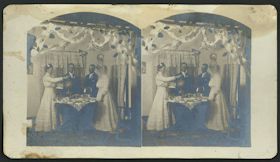 Double the pleasure, double the fun. Many stereographs were sold in sets—some showing exotic lands and peoples, others showing everyday sights and activities in small town America. The image to the right, “Double wedding” (Nebraska State Historical Society Collection), shows two couples celebrating their wedding day. In many of the stereographs, as in this one, the two pictures appear to be duplicates.
Double the pleasure, double the fun. Many stereographs were sold in sets—some showing exotic lands and peoples, others showing everyday sights and activities in small town America. The image to the right, “Double wedding” (Nebraska State Historical Society Collection), shows two couples celebrating their wedding day. In many of the stereographs, as in this one, the two pictures appear to be duplicates.
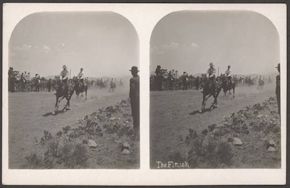
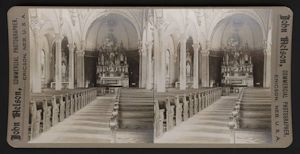 Sometimes, though, the pictures were cropped slightly on one side or the other as can be seen at the left in “The Finish” (Nebraska State Historical Society Collection), where the not as much of the man at the right in the right image shows as in the image on the left. Other times, the photographer would shift the camera slightly to take a second photograph. That might be the case in the picture to the right of “Interior of church and altar in Greeley Centre, Nebraska” (Nebraska State Historical Society Collection)—you do need to look closely to see the slight shift in angle between the two images..
Sometimes, though, the pictures were cropped slightly on one side or the other as can be seen at the left in “The Finish” (Nebraska State Historical Society Collection), where the not as much of the man at the right in the right image shows as in the image on the left. Other times, the photographer would shift the camera slightly to take a second photograph. That might be the case in the picture to the right of “Interior of church and altar in Greeley Centre, Nebraska” (Nebraska State Historical Society Collection)—you do need to look closely to see the slight shift in angle between the two images..

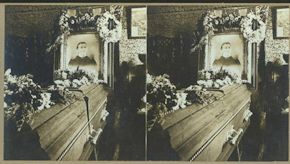 Anything might have been considered fair game as subject matter for stereographs. For example, at the right is a winter scene of the home of a Fremont, Nebraska, resident, Robert S. Somers (Keene Memorial Library Collection) and at the left a “Funeral casket” (Nebraska State Historical Society Collection). Check out other stereographs in Nebraska Memories which include the interiors of stores and homes, farming activities, commercial and public buildings, Native Americans, and Missouri River flooding.
Anything might have been considered fair game as subject matter for stereographs. For example, at the right is a winter scene of the home of a Fremont, Nebraska, resident, Robert S. Somers (Keene Memorial Library Collection) and at the left a “Funeral casket” (Nebraska State Historical Society Collection). Check out other stereographs in Nebraska Memories which include the interiors of stores and homes, farming activities, commercial and public buildings, Native Americans, and Missouri River flooding.
Visit Nebraska Memories to search for or browse through many more historical images digitized from photographs, negatives, postcards, maps, lantern slides, books and other materials.
Nebraska Memories is a cooperative project to digitize Nebraska-related historical and cultural heritage materials and make them available to researchers of all ages via the Internet. Nebraska Memories is brought to you by the Nebraska Library Commission. If your institution is interested in participating in Nebraska Memories, see http://nlc.nebraska.gov/nebraskamemories/participation.aspx for more information, or contact Beth Goble, Historical Projects Librarian, or Devra Dragos, Technology & Access Services Director.
Posted in Nebraska Memories
Leave a comment
Go Old Gold Knights!
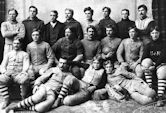 … er, make that Cornhuskers, Big Red? Team names can change over time and the athletic teams at the University of Nebraska Lincoln have answered to several. These handsome young men didn’t let the name Bugeaters (or the striped knee socks) prevent them from taking the championship in 1894 (Townsend Studio Collection). It’s only one week until the first game of UNL’s 2013 season–here’s hoping the Cornhuskers do as well.
… er, make that Cornhuskers, Big Red? Team names can change over time and the athletic teams at the University of Nebraska Lincoln have answered to several. These handsome young men didn’t let the name Bugeaters (or the striped knee socks) prevent them from taking the championship in 1894 (Townsend Studio Collection). It’s only one week until the first game of UNL’s 2013 season–here’s hoping the Cornhuskers do as well.
Other UNL football-related images in Nebraska Memories include photographs and a score. Jack Best, an athletic trainer, worked with the team for many years (Townsend Studio Collection). In 1909, Robert W. Stevens, a faculty member, wrote the musical piece “The Cornhusker,” dubbed the “Official Field Song of the University of Nebraska” which includes two “Foot-ball Verses” (Polley Music Library Collection). One verse exhorts the team: “Come a runnin’ boys, Don’t you hear that noise like the thunder in the sky, How it rolls along in a good old song from the sons of Nebraski, Now it’s coming near with a rising cheer that will sweep all foes away, So with all our vim, We are bound to win and we’re going to win today.”
UNL was not the only Nebraska school to field a football team. The four lineman from the Normal School at Kearney cleaned up really well for the photograph at the left (University of Nebraska at Kearney Collection). Other schools’ team photos in Nebraska Memories include Wayne State College, David City High School, Nebraska School for the Deaf, and the Whittier School (Lincoln Public Schools Collection) shown at the right. See more photographs of football players from various teams through the years in Nebraska Memories.
 Nor was UNL the only school to draw crowds to their football games, although it has long been the joke that on Saturday home football games, Memorial Stadium is the third largest city in Nebraska–and growing. As the picture at the left shows, Kearney Normal school also had many enthusiastic fans (University of Nebraska at Kearney Collection).
Nor was UNL the only school to draw crowds to their football games, although it has long been the joke that on Saturday home football games, Memorial Stadium is the third largest city in Nebraska–and growing. As the picture at the left shows, Kearney Normal school also had many enthusiastic fans (University of Nebraska at Kearney Collection).
Visit Nebraska Memories to search for or browse through many more historical images digitized from photographs, negatives, postcards, maps, lantern slides, books and other materials.
Nebraska Memories is a cooperative project to digitize Nebraska-related historical and cultural heritage materials and make them available to researchers of all ages via the Internet. Nebraska Memories is brought to you by the Nebraska Library Commission. If your institution is interested in participating in Nebraska Memories, see http://nlc.nebraska.gov/nebraskamemories/participation.aspx for more information, or contact Beth Goble, Historical Projects Librarian, or Devra Dragos, Technology & Access Services Director.
Posted in Nebraska Memories, Technology
Leave a comment
Take Me Out to the Ball Game
The crack of the bat on a ball, the smack of a ball hitting a mitt, and the umpire’s cry of “You’re out!” Ah, the sounds of summer. America’s most popular pastime hit a home run in early Nebraska–be it high school, college, league or pick-up at the sandlot, boys and men enjoyed a game of baseball.
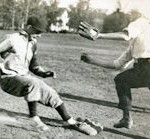 In this Union College game from 1911-1912, the player sliding into base wears a uniform, while the player stretching a mitt to catch the ball looks to be wearing street clothes. Other college photos in Nebraska Memories show the teams lined up in uniform, sometimes with coaches and ball boys. Towns, big and small, also had their teams and fans showed up to the games.
In this Union College game from 1911-1912, the player sliding into base wears a uniform, while the player stretching a mitt to catch the ball looks to be wearing street clothes. Other college photos in Nebraska Memories show the teams lined up in uniform, sometimes with coaches and ball boys. Towns, big and small, also had their teams and fans showed up to the games.
 Younger boys may have played in a league or, as in this picture, in a pick-up game on a lot or playground. These boys don’t seem to have had a home plate or bags for the bases, but there seem to be plenty of bats and mitts as the pitcher winds up for a pitch. And there wouldn’t have been a problem of spiking, as more than one of the boys appears to be barefoot.
Younger boys may have played in a league or, as in this picture, in a pick-up game on a lot or playground. These boys don’t seem to have had a home plate or bags for the bases, but there seem to be plenty of bats and mitts as the pitcher winds up for a pitch. And there wouldn’t have been a problem of spiking, as more than one of the boys appears to be barefoot.
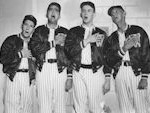 Baseball even made an appearance on-stage at the Omaha Community Playhouse with a production of Damn Yankees. These unnamed Omaha crooners may or may not have played baseball at some time in real life, but I’m sure they were crowd pleasers.
Baseball even made an appearance on-stage at the Omaha Community Playhouse with a production of Damn Yankees. These unnamed Omaha crooners may or may not have played baseball at some time in real life, but I’m sure they were crowd pleasers.
Visit Nebraska Memories to search for or browse through many more historical images digitized from photographs, negatives, postcards, maps, lantern slides, books and other materials.
Nebraska Memories is a cooperative project to digitize Nebraska-related historical and cultural heritage materials and make them available to researchers of all ages via the Internet. Nebraska Memories is brought to you by the Nebraska Library Commission. If your institution is interested in participating in Nebraska Memories, see http://nlc.nebraska.gov/nebraskamemories/participation.aspx for more information, or contact Beth Goble, Historical Projects Librarian, or Devra Dragos, Technology & Access Services Director.
Posted in Nebraska Memories
Leave a comment
Where do writers get their ideas?
A common answer to this question may be: anywhere and everywhere. So what can they do if they hit a writer’s block or don’t know how to describe something historical? Our suggestion is–try Nebraska Memories!
The photograph and description of Dr. Muriel Anderson, a blind osteopath who practiced in David City, Nebraska, from 1924 to 1971 can generate many questions and ideas. What would it be like to be a blind doctor? How would your other senses take over when you couldn’t see a patient? What kind of challenges did she face in her medical education in the early 1920s–as a woman, as well as being blind? What other challenging occupations did women with disabilities become successful in during that time? What would it be like to be a patient of a blind doctor? What would happen if a patient tried to pull a fast one on the doctor? What if … ? Now you fill in the blank.
A writer may have an idea but might not be sure how to describe the scene. Say your heroine is working in a state institution caring for patients with tuberculosis, what would the patient housing be like? What type of buildings were at a state institution? What type of people were cared for at state institutions? What was life like at a state institution? What did rooms look like in homes, schools, stores, manufacturing plants, and other buildings?
A writer might wonder: what did people wear when they were working? What did they wear to have a studio portrait taken? What did they do for fun? What did small western towns look like? What did bigger towns look like? What kind of pets did they have? Find images and stories about all of these at Nebraska Memories.
Nebraska Memories is a cooperative project to digitize Nebraska-related historical and cultural heritage materials and make them available to researchers of all ages via the Internet. Nebraska Memories is brought to you by the Nebraska Library Commission. If your institution is interested in participating in Nebraska Memories, see http://nlc.nebraska.gov/nebraskamemories/participation.aspx for more information, or contact Beth Goble, Historical Projects Librarian, or Devra Dragos, Technology & Access Services Director.
Posted in Nebraska Memories
Leave a comment
Lending e-Reader Devices at Your Library?
You may want to take a look at an advisory issued by the Institute of Museum and Library Services if you are currently lending, or are thinking about lending, e-Reader devices. The Department of Justice found that two libraries offering devices were in violation of Section 504 of the Rehabilitation Act of 1973 and the Americans with Disabilities Act of 1990. In its advisory, IMLS highlights applicable parts of the laws, outlines the settlement of the complaint against each library, and encourages libraries to think about these issues as they acquire new public access technologies
Posted in Books & Reading, Library Management, Technology
1 Comment
Celebrating Dear Old Dad
The first Father’s Day celebration was held in Spokane, Washington, in 1910. But it wasn’t until forty years ago Father’s Day finally became a permanent national holiday. It took 62 years of promotion and lobbying to overcome resistance to another “commercial” holiday.
 No matter how you celebrate Father’s Day (commercially or otherwise), it can be great fun to look back at images of fathers from the past–or grandfathers, great-grandfathers and fathers of the future. Many images of fathers in Nebraska Memories were taken by Harvey L. Boston, owner of a photography studio in David City, Nebraska, (from 1893 to 1927) including a self-portait with his two young daughters.
No matter how you celebrate Father’s Day (commercially or otherwise), it can be great fun to look back at images of fathers from the past–or grandfathers, great-grandfathers and fathers of the future. Many images of fathers in Nebraska Memories were taken by Harvey L. Boston, owner of a photography studio in David City, Nebraska, (from 1893 to 1927) including a self-portait with his two young daughters.
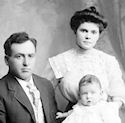
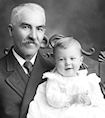 Boston’s photographs include young fathers, such as Fred Keller, at left with his wife, Alice, and their young child. The collection also includes fathers who might have started a second family at an older age, such as William H. McGaffin, at right, who was photographed with his son Wesley, born when his father over 60. McGaffin, a widower who married a second time, had already had 14 children with his first wife.
Boston’s photographs include young fathers, such as Fred Keller, at left with his wife, Alice, and their young child. The collection also includes fathers who might have started a second family at an older age, such as William H. McGaffin, at right, who was photographed with his son Wesley, born when his father over 60. McGaffin, a widower who married a second time, had already had 14 children with his first wife.
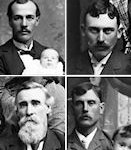
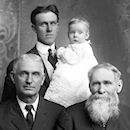
 Other Boston images show multiple generations. The collage to the far left includes members of the Gilbert W. Rogers family; in the photograph two fathers are holding younger children. In the center are four generations of the H. W. Lichliter family. And to the right are four generations of the Harper family: James, Morgan, Jack and Phillip.
Other Boston images show multiple generations. The collage to the far left includes members of the Gilbert W. Rogers family; in the photograph two fathers are holding younger children. In the center are four generations of the H. W. Lichliter family. And to the right are four generations of the Harper family: James, Morgan, Jack and Phillip.

 Some Nebraska Memories images show fathers at work with their children, such as Joe Gatto with his two sons in his store in Lincoln, Nebraska (from the Townsend Studio collection). Others show them relaxing with their families, like the John Birkel family to the right. But, work or play, take some time to celebrate all fathers!
Some Nebraska Memories images show fathers at work with their children, such as Joe Gatto with his two sons in his store in Lincoln, Nebraska (from the Townsend Studio collection). Others show them relaxing with their families, like the John Birkel family to the right. But, work or play, take some time to celebrate all fathers!
Visit Nebraska Memories to search for or browse through many more historical images digitized from photographs, negatives, postcards, maps, lantern slides, books and other materials.
Nebraska Memories is a cooperative project to digitize Nebraska-related historical and cultural heritage materials and make them available to researchers of all ages via the Internet. Nebraska Memories is brought to you by the Nebraska Library Commission. If your institution is interested in participating in Nebraska Memories, see http://nlc.nebraska.gov/nebraskamemories/participation.aspx for more information, or contact Beth Goble, Government Information Services Director, or Devra Dragos, Technology & Access Services Director.
Is there a doctor in the house?
 Have you ever needed a ride to the hospital? Or emergency medical care? Consider the medical care available 80-100 years ago. It used to be that ambulances simply transported a person to the hospital (or the morgue). Check out the image of this ambulance used in Lincoln in 1922. (Hodgman ambulance, Townsend Studio collection) You might not get much medical aid on the trip, but there are curtains to close for privacy.
Have you ever needed a ride to the hospital? Or emergency medical care? Consider the medical care available 80-100 years ago. It used to be that ambulances simply transported a person to the hospital (or the morgue). Check out the image of this ambulance used in Lincoln in 1922. (Hodgman ambulance, Townsend Studio collection) You might not get much medical aid on the trip, but there are curtains to close for privacy.
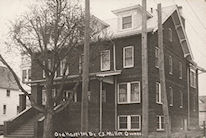 No matter how you reached the hospital all those years ago, you might still have a problem getting into the building. At the Ord Hospital (and others), you had to navigate quite a few stairs to the front entrance. (Ord Hospital, Nebraska State Historical Society collection)
No matter how you reached the hospital all those years ago, you might still have a problem getting into the building. At the Ord Hospital (and others), you had to navigate quite a few stairs to the front entrance. (Ord Hospital, Nebraska State Historical Society collection)
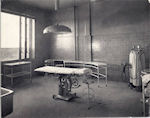 Once inside the hospital, there weren’t many bells and whistles like today. In this image from the Alegent Health Immanuel Medical Center collection, the operating room is plain and simple. A basin for the staff to wash up in, a table that could be raised and lowered, a single light fixture above the table–but hey, there were large windows for extra light, and they opened for fresh air, too.
Once inside the hospital, there weren’t many bells and whistles like today. In this image from the Alegent Health Immanuel Medical Center collection, the operating room is plain and simple. A basin for the staff to wash up in, a table that could be raised and lowered, a single light fixture above the table–but hey, there were large windows for extra light, and they opened for fresh air, too.
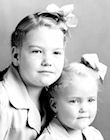
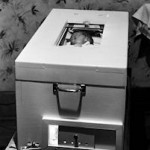 Other mechanical improvements, such as the incubator in the image to the left, may look clunky and out-of-date to us, but you can’t argue with success. The image to the right shows Nancy Lonn, the baby in the incubator, at age four with her older sister Belva Joy. (Thorpe Opera House Foundation/Boston Studio Project collection)
Other mechanical improvements, such as the incubator in the image to the left, may look clunky and out-of-date to us, but you can’t argue with success. The image to the right shows Nancy Lonn, the baby in the incubator, at age four with her older sister Belva Joy. (Thorpe Opera House Foundation/Boston Studio Project collection)
Check out more medical-related images or visit Nebraska Memories to search for or browse through many more historical images digitized from photographs, negatives, postcards, maps, lantern slides, books and other materials.
Nebraska Memories is a cooperative project to digitize Nebraska-related historical and cultural heritage materials and make them available to researchers of all ages via the Internet. Nebraska Memories is brought to you by the Nebraska Library Commission. If your institution is interested in participating in Nebraska Memories, see http://nlc.nebraska.gov/nebraskamemories/participation.aspx for more information, or contact Beth Goble, Government Information Services Director, or Devra Dragos, Technology & Access Services Director.
Posted in General, Information Resources, Nebraska Memories, Technology
1 Comment
Nebraska Business Offers Libraries Wholesale Pricing
Liu & DB Enterprises, Inc. has been added to the Library Commission’s Discounts on Books & Supplies page.
Liu & DB Enterprises, Inc. is a wholesale distributor of CD/DVD Media and Packaging. The company is a Nebraska family-owned company in La Vista, Nebraska near Omaha. We are one of the largest suppliers of media packaging in the US as regards to the varieties of products. LDB carries over 1,000 media and packaging products at our 32,000 sq. ft. La Vista facility and serves both domestic and international customers.
Pricing for Nebraska libraries will be wholesale pricing for items such as brand new, high quality 1 to 14 capacity DVD cases.
For more information, including ordering instructions, see the company’s entry on the Discounts on Books & Supplies page.
Posted in General
Leave a comment
Taking a Stroll
 … down Memory Lane, er, Main Street. Before suburbs and big box stores, the main street was the heart of many towns. Out on the plains, main streets in many small towns probably began looking something like Crawford’s does in this image from the Crawford Historical Society and Museum Collection. Not enough traffic to keep down the weeds yet, and wooden buildings under construction.
… down Memory Lane, er, Main Street. Before suburbs and big box stores, the main street was the heart of many towns. Out on the plains, main streets in many small towns probably began looking something like Crawford’s does in this image from the Crawford Historical Society and Museum Collection. Not enough traffic to keep down the weeds yet, and wooden buildings under construction.
 In towns that had been established for a little longer, the main streets became hardened dirt—unless there was enough rain to turn it into mud. And while there is still space between the wooden structures on Sacramento’s main street, progress can be seen in the signage on the buildings and the number of people in the picture. Image from the Phelps County Historical Society Collection.
In towns that had been established for a little longer, the main streets became hardened dirt—unless there was enough rain to turn it into mud. And while there is still space between the wooden structures on Sacramento’s main street, progress can be seen in the signage on the buildings and the number of people in the picture. Image from the Phelps County Historical Society Collection.
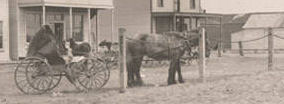 As more businesses and government buildings went up, amenities such as hitching posts became necessary. In this image of Ericson from the Nebraska State Historical Society Collection, between the stores on one side of Main Street and the Post Office on the other a rope has been strung along several posts for wagon parking down the middle of the street. Notice that the buildings are all wooden structures.
As more businesses and government buildings went up, amenities such as hitching posts became necessary. In this image of Ericson from the Nebraska State Historical Society Collection, between the stores on one side of Main Street and the Post Office on the other a rope has been strung along several posts for wagon parking down the middle of the street. Notice that the buildings are all wooden structures.
 Modern inventions like electricity and the telephone brought poles and wires to town. This image of Eagle’s Main Street shows poles down both sides of the street where it looks like paring for wagons and buggies is limited mostly to the west side of the street—or one business is really popular! Note that there is one brick building on the right-side of the street. This image is from the Jane Pope Geske Heritage Room of Nebraska Authors Collection.
Modern inventions like electricity and the telephone brought poles and wires to town. This image of Eagle’s Main Street shows poles down both sides of the street where it looks like paring for wagons and buggies is limited mostly to the west side of the street—or one business is really popular! Note that there is one brick building on the right-side of the street. This image is from the Jane Pope Geske Heritage Room of Nebraska Authors Collection.
 By the 1930s most poles and lines have been banished to the alleys. And as seen on Fairmont’s Main Street, street lights have been installed in front of brick buildings. Hitching posts have disappeared and no parking meters have appeared as yet in this image from the Fairmont Public Library/Fillmore County Historical Society Collection.
By the 1930s most poles and lines have been banished to the alleys. And as seen on Fairmont’s Main Street, street lights have been installed in front of brick buildings. Hitching posts have disappeared and no parking meters have appeared as yet in this image from the Fairmont Public Library/Fillmore County Historical Society Collection.
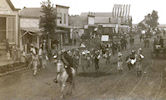 And over the years, big events in town took place on Main Street, like Fourth of July parades, political speeches, and the Calathumpian Parade shown here in Fremont. This image is part of the Keene Memorial Library Collection.
And over the years, big events in town took place on Main Street, like Fourth of July parades, political speeches, and the Calathumpian Parade shown here in Fremont. This image is part of the Keene Memorial Library Collection.
Visit Nebraska Memories to search for or browse through many more historical images digitized from photographs, negatives, postcards, maps, lantern slides, books and other materials.
Nebraska Memories is a cooperative project to digitize Nebraska-related historical and cultural heritage materials and make them available to researchers of all ages via the Internet. Nebraska Memories is brought to you by the Nebraska Library Commission. If your institution is interested in participating in Nebraska Memories, see http://nlc.nebraska.gov/nebraskamemories/participation.aspx for more information, or contact Beth Goble, Government Information Services Director, or Devra Dragos, Technology & Access Services Director.
To Top It Off
Hats, bonnets (sun, poke, cottage, drawn), caps, berets, turbans, wimples, fascinators, hoods, pillboxes, boaters, cloches, bandeaux, chapeaux … warmth, protection or fashion statement?
Few women in Nebraska wear hats on a regular basis anymore, unless they belong to a special group. However, it used to be that women wouldn’t be seen out in public without one. While many women’s head coverings may have been worn to keep the head warm or protect the face from the sun, there were more reasons for wearing them.

 Some head coverings represent a profession or calling. Evelyn Powell is pictured in a US Naval Reserve (Women’s Reserve) uniform in the last year of World War II. [These women were also known as WAVES which stood for Women Accepted for Volunteer Emergency Service.] Emily Anderson wears the cap symbolic of the nursing profession. These and the portrait images in this post are from the Butler County Gallery Collection.
Some head coverings represent a profession or calling. Evelyn Powell is pictured in a US Naval Reserve (Women’s Reserve) uniform in the last year of World War II. [These women were also known as WAVES which stood for Women Accepted for Volunteer Emergency Service.] Emily Anderson wears the cap symbolic of the nursing profession. These and the portrait images in this post are from the Butler County Gallery Collection.

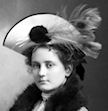 But outside of the professional use, many hats were definitely worn as a fashion statement. Birds and their feathers were popular for decorations, making some hats pure flights of fancy. The hat to the left, worn by Dana Fenlon, has full wings to takeoff. Others, like the one worn by Bertha Neal at right, limited themselves to a few feathers.
But outside of the professional use, many hats were definitely worn as a fashion statement. Birds and their feathers were popular for decorations, making some hats pure flights of fancy. The hat to the left, worn by Dana Fenlon, has full wings to takeoff. Others, like the one worn by Bertha Neal at right, limited themselves to a few feathers.
 Flowers and bows were also popular. Hazel Walker’s hat is limited to blossoms. Other decorations abound on the many women’s hats found in the images of Nebraska Memories. And, for those who needed help in making a statement,
Flowers and bows were also popular. Hazel Walker’s hat is limited to blossoms. Other decorations abound on the many women’s hats found in the images of Nebraska Memories. And, for those who needed help in making a statement,  there was great fun in trying on the latest creations in the millinery department of the local store, such as the one in the Nebraska Clothing Company.
there was great fun in trying on the latest creations in the millinery department of the local store, such as the one in the Nebraska Clothing Company.
Visit Nebraska Memories to search for or browse through many more historical images digitized from photographs, negatives, postcards, maps, lantern slides, books and other materials.
Nebraska Memories is a cooperative project to digitize Nebraska-related historical and cultural heritage materials and make them available to researchers of all ages via the Internet. Nebraska Memories is brought to you by the Nebraska Library Commission. If your institution is interested in participating in Nebraska Memories, see http://nlc.nebraska.gov/nebraskamemories/participation.aspx for more information, or contact Beth Goble, Government Information Services Director, or Devra Dragos, Technology & Access Services Director.
Posted in General, Information Resources, Nebraska Memories
Leave a comment
Motoring On
On September 27, 1908, the first Ford Model T left the factory. Henry Ford’s Model T changed the transportation industry by supplying affordable cars to everyone at $850 per car as opposed to $1,000-$2,000 from other manufacturers. Ford accomplished this by developing assembly line manufacturing which speeded up production and, in turn, helped lower prices.
 Nebraskans were no different than the rest of the world when it came to an interest in automobiles. A number of them tried their hand at designing and/or building their own motor vehicles. Some were big and bulky as you can see in this image of the M.H. Miller vehicle, from the Townsend Collection.
Nebraskans were no different than the rest of the world when it came to an interest in automobiles. A number of them tried their hand at designing and/or building their own motor vehicles. Some were big and bulky as you can see in this image of the M.H. Miller vehicle, from the Townsend Collection.
Others were sleek  and racy, such as the car shown in these images with just its chassis and then the completed vehicle in front of Central Auto
and racy, such as the car shown in these images with just its chassis and then the completed vehicle in front of Central Auto Repair and Machine Works from the Townsend Collection. In addition, to manufacturing companies and auto repair shops, other automobile-related businesses opened, too, such as dealerships, services stations, automobile associations, etc.
Repair and Machine Works from the Townsend Collection. In addition, to manufacturing companies and auto repair shops, other automobile-related businesses opened, too, such as dealerships, services stations, automobile associations, etc.
 W.L Huffman Auto Company was one of many car dealerships that sprang up around the state to sell these new machines—and not just those from the big three American automobile companies that are around today. This dealership, for example, sold Hupmobiles and Detroit Electric cars as shown in this photograph from the Townsend Collection.
W.L Huffman Auto Company was one of many car dealerships that sprang up around the state to sell these new machines—and not just those from the big three American automobile companies that are around today. This dealership, for example, sold Hupmobiles and Detroit Electric cars as shown in this photograph from the Townsend Collection.
 And people had fun with their new vehicles—using them for racing, endurance tests, or decorating them for parades—like this Decorated automobile image from the Nebraska State Historical Society Collection. To see many more automobile and automobile-related images, check out Nebraska Memories.
And people had fun with their new vehicles—using them for racing, endurance tests, or decorating them for parades—like this Decorated automobile image from the Nebraska State Historical Society Collection. To see many more automobile and automobile-related images, check out Nebraska Memories.
Visit Nebraska Memories to search for or browse through many more historical images digitized from photographs, negatives, postcards, maps, lantern slides, books and other materials.
Nebraska Memories is a cooperative project to digitize Nebraska-related historical and cultural heritage materials and make them available to researchers of all ages via the Internet. Nebraska Memories is brought to you by the Nebraska Library Commission. If your institution is interested in participating in Nebraska Memories, see http://nlc.nebraska.gov/nebraskamemories/participation.aspx for more information, or contact Beth Goble, Government Information Services Director,
or Devra Dragos, Technology & Access Services Director.
What else happened?
 “The building was completely destroyed by fire on October 31, 1947. The fire started about 11:00 p.m. in the projection room after the second show. About 100 people were in the building. Everyone got out unharmed.” (Opera House, Valley, Neb. from the Valley Public Library collection)
“The building was completely destroyed by fire on October 31, 1947. The fire started about 11:00 p.m. in the projection room after the second show. About 100 people were in the building. Everyone got out unharmed.” (Opera House, Valley, Neb. from the Valley Public Library collection)
When we talk to new and prospective participants to the Nebraska Memories Project, we ask that the images contributed be identified with the basic who, what, where, and when for a general description. But, as we have heard time and again, people especially enjoy the additional stories or information that participating institutions gather about their items. Where does the information come from—the basic as well as extra? Well, participants often use the traditional research tools such as old newspapers, local history books and census records. But many of them also tap into people’s knowledge and memories.
The Valley Public Library, in addition to questioning people individually, organized a coffee and cookies event at the local café. According to Gerri Nordell, invitations were mailed out and transportation arranged to bring in about twenty folks from their homes or the local care facility. Magnifying glasses helped with the small details in photographs, and one person’s memories nudged another’s. After two hours, “they left … still talking about the ‘good old days’.”
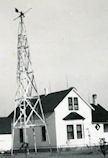 In Sidney, people’s memories had already been tapped for a book on local history. But two volunteers in particular who ran the Cheyenne County Historical Society and Museum added extra details when working with Commission staff. In small communities, these older people often know all the local businesses, families and their homes. And the information, as is found in the record’s Historical Notes field for this image (George and Mabel Jung farm with early wind power from the Cheyenne County Historical Society and Museum collection), can provide insights into the lives and living conditions of people in Nebraska and the Midwest during those earlier times.
In Sidney, people’s memories had already been tapped for a book on local history. But two volunteers in particular who ran the Cheyenne County Historical Society and Museum added extra details when working with Commission staff. In small communities, these older people often know all the local businesses, families and their homes. And the information, as is found in the record’s Historical Notes field for this image (George and Mabel Jung farm with early wind power from the Cheyenne County Historical Society and Museum collection), can provide insights into the lives and living conditions of people in Nebraska and the Midwest during those earlier times.
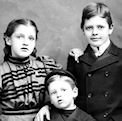 Another volunteer-run project, the Butler County Gallery collection (which consists mostly of studio portraits), used a different approach in tapping people resources. Whenever they heard a family reunion was to be held, they would reach out to promote their collection and ask for information. Feedback included people’s names, birth and death dates, professions and activities, and personal stories. And, of course, corrections! Such was the case with this photograph of Lyle, Fay and Garth Osterhout.
Another volunteer-run project, the Butler County Gallery collection (which consists mostly of studio portraits), used a different approach in tapping people resources. Whenever they heard a family reunion was to be held, they would reach out to promote their collection and ask for information. Feedback included people’s names, birth and death dates, professions and activities, and personal stories. And, of course, corrections! Such was the case with this photograph of Lyle, Fay and Garth Osterhout.
So, if your Nebraska institution has Nebraska-related historical materials that others could enjoy, learn from, or contribute stories to, consider becoming a Nebraska Memories participant. The Nebraska Library Commission hosts the database and will work with your staff on selection of appropriate materials, scanning the items and gathering information to create descriptive records. For more information about participating, see http://nlc.nebraska.gov/nebraskamemories/participation.aspx, or contact Beth Goble, Government Information Services Director, or Devra Dragos, Technology & Access Services Director.
Nebraska Memories is a cooperative project to digitize Nebraska-related historical and cultural heritage materials and make them available to researchers of all ages via the Internet. Visit Nebraska Memories to search for or browse through many more historical images digitized from photographs, negatives, postcards, maps, lantern slides, books and other materials.
On the Road Again
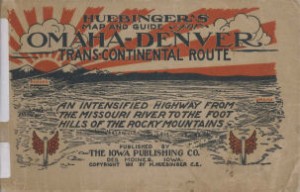 Planning a road trip this summer? Taking along a GPS device? Check out this old-fashioned positioning system— Huebinger’s Map and Guide for Omaha-Denver Trans-continental Route : with Supplement Showing Overland Trail Connecting Omaha-Denver Trans-continental Route at Lincoln with the Waubonsie Trail at Nebraska City (1911) from the Hastings Public Library Collection in Nebraska Memories.
Planning a road trip this summer? Taking along a GPS device? Check out this old-fashioned positioning system— Huebinger’s Map and Guide for Omaha-Denver Trans-continental Route : with Supplement Showing Overland Trail Connecting Omaha-Denver Trans-continental Route at Lincoln with the Waubonsie Trail at Nebraska City (1911) from the Hastings Public Library Collection in Nebraska Memories.
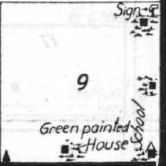 If you are driving east and coming up on Harvard, Nebraska, (page 136) be on the lookout for the green-painted house on the left and then a school where you would turn north. Then, after you pass a pond on the left and a batten-board barn on the right, be ready for a right-turn to head east again. Of course, it helps if you have a navigator along to read off the landmarks.
If you are driving east and coming up on Harvard, Nebraska, (page 136) be on the lookout for the green-painted house on the left and then a school where you would turn north. Then, after you pass a pond on the left and a batten-board barn on the right, be ready for a right-turn to head east again. Of course, it helps if you have a navigator along to read off the landmarks.
Once you’ve made it to Harvard (480.4 miles from Denver and only another 151.9 to Omaha) , do you need a hotel for the night? Try Hotel Harvard—only two dollars on the American plan. Or perhaps you need a garage to top off the gas tank? Two choice are listed. Would you like more information about Harvard and its residents? Check out page 22.
Another book of maps in this collection, Official Road Book of the Nebraska State Automobile Association (1913), includes a digest of states’ auto laws, telling motorists that in Nebraska, they must register with the Secretary of State in Lincoln for a fee of $2 per year and supply their own tags. And keep a light foot on the gas pedal because the speed limits are “10 miles an hour in business section; 15 miles in residence district; 20 miles elsewhere.”
Now, as you pull out of Harvard and head on down the road toward Omaha, keep an eye out for the danger sign ahead by the red barn …
Visit Nebraska Memories to search for or browse through many more historical images digitized from maps, photographs, negatives, postcards, lantern slides, books and other materials.
Nebraska Memories is a cooperative project to digitize Nebraska-related historical and cultural heritage materials and make them available to researchers of all ages via the Internet. Nebraska Memories is brought to you by the Nebraska Library Commission. If your institution is interested in participating in Nebraska Memories, see http://nlc.nebraska.gov/nebraskamemories/participation.aspx for more information, or contact Beth Goble, Government Information Services Director, or Devra Dragos, Technology & Access Services Director.
Down on the Farm
It’s summer, farmers are working hard, and crops and animals are growing. If you are interested in seeing farm life from a century or so ago, check out Nebras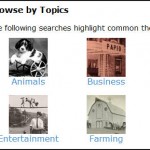 ka Memories, a database containing historical images digitized from photographs, negatives, postcards, maps, lantern slides, books and other materials.
ka Memories, a database containing historical images digitized from photographs, negatives, postcards, maps, lantern slides, books and other materials.
Browse and Search provide different ways to find images in Nebraska Memories. On the Browse page, under “Browse by Topics” is a link to a sample of “Farming” images. If you want to see more images like the one you are looking at, click one of the subject headings from the item description.
 For example, you could click “Tractors” in this item record to find more images with tractors in the Nebraska State Historical Society collection.
For example, you could click “Tractors” in this item record to find more images with tractors in the Nebraska State Historical Society collection.
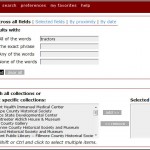 To find images of tractors in one or more of the collections, go to “Search” and type in the tractors. The search capability also provides the option to search in specific fields, so you can combine searches, such as title and description, or you can limit by date. If you wish, the search can also be limited by collection.
To find images of tractors in one or more of the collections, go to “Search” and type in the tractors. The search capability also provides the option to search in specific fields, so you can combine searches, such as title and description, or you can limit by date. If you wish, the search can also be limited by collection.
So pick your favorite topic, dig into Nebraska Memories, and harvest information for your personal or educational adventures into Nebraska history.
Nebraska Memories is a cooperative project to digitize Nebraska-related historical and cultural heritage materials and make them available to researchers of all ages via the Internet. Nebraska Memories is brought to you by the Nebraska Library Commission. If your institution is interested in participating in Nebraska Memories, see http://nlc.nebraska.gov/nebraskamemories/participation.aspx for more information, or contact Beth Goble, Government Information Services Director, or Devra Dragos, Technology & Access Services Director.
Posted in General, Nebraska Memories, Technology
Leave a comment
Flying the Flag
 The U.S. flag has been displayed for many different reasons and occasions. In Nebraska Memories, some photographs and postcards show flags on regular display both outside and inside buildings. An example is this colorful postcard of the “Old People’s Home, Fontenelle Boulevard, Omaha, Nebr.” from the Omaha Public Library collection. On some of the larger images of the flag, try counting the stars—many of these flags would have had only 46. Here are more images.
The U.S. flag has been displayed for many different reasons and occasions. In Nebraska Memories, some photographs and postcards show flags on regular display both outside and inside buildings. An example is this colorful postcard of the “Old People’s Home, Fontenelle Boulevard, Omaha, Nebr.” from the Omaha Public Library collection. On some of the larger images of the flag, try counting the stars—many of these flags would have had only 46. Here are more images.
More photographs show the flag being used to decorate buildings, cars and floats for celebrations and special occasions. If one flag is good, more must be better, as in the “Decorated automobile” to the left, right? And, of course, you can always borrow the design, as the “Man and woman wearing flag print clothing” to the right have done. Both photographs are from the Nebraska State Historical Society collection. Also see these special occasion images.
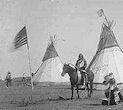
The flag is also used for ceremonial purposes or solemn occasions by the military and other groups. Several Nebraska State Historical images show the American flag at Native American gatherings including “Tipis of chiefs” from 1911. See more ceremonial images.
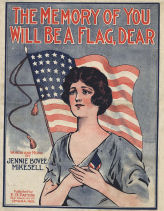
Before “The Star-Spangled Banner” became the U.S. national anthem in 1931, other patriotic songs were also written using our flag as a rallying point to protect “the republic for which it stands”. The musical score, “The Memory of You Will Be a Flag, Dear” from the Polley Music Library collection, is one of several available in Nebraska Memories.
Visit Nebraska Memories to search for or browse through many more historical images digitized from photographs, negatives, postcards, maps, lantern slides, books and other materials.
Nebraska Memories is a cooperative project to digitize Nebraska-related historical and cultural heritage materials and make them available to researchers of all ages via the Internet. Nebraska Memories is brought to you by the Nebraska Library Commission. If your institution is interested in participating in Nebraska Memories, see http://www.nlc.state.ne.us/nebraskamemories/ for more information, or contact Beth Goble, Government Information Services Director, or Devra Dragos, Technology & Access Services Director.




